Basketball: Making the 3-pointer a priority in your offense
Revered basketball coach Don Meyer coached squads that led the country in scoring average on five separate occasions. His teams typically featured a balance of low-post players who score close to the hoop, and outside sharp-shooters who pick up extra points by standing outside the arc. His teams don’t rely on the 3-pointer but they incorporate it as a part of their offense.
To make the 3-pointer an effective weapon in your offense, try some of Meyer’s favorite 3-point drills, then check out some of his basic 3-point plays against man and zone defense.
3-point drill
A staple in Meyer’s programs, this 3-point drill begins with a game of 3-on-3, then incorporates a post player before finally working in screens.

DIAGRAM 1: 3-point drill basic. Have players go 3-on-3, trying to get good looks at 3-pointers. The offense looks to penetrate to draw the defense, while defenders try to stay home on their man and not drawn into the lane, which allows the offense to kick the ball out for an open shot. Playing only with basic movement on the perimeter is not an easy way for the offense to get 3-pointers, which is why Meyer uses this drill.
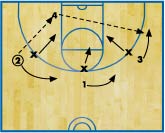
DIAGRAM 2: 3-point drill with post. Add an uncovered post player into the mix. The offense passes into the post to deflate some of the pressure on the perimeter. This allows perimeter players to move into passing lanes for better looks at the basket. In this example, the post (4) skips a pass to the opposite side, where an open shooter (3) is ready.
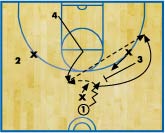
DIAGRAM 3: 3-point drill with screen. Allow players to screen for each other in the final segment of the drill. In the example, 1 dribbles to the right, while 3 comes out to set a ball screen. If 4 is a good shooter, have 4 come from the post to the perimeter. 1 uses the ball screen, dribbles around it and kicks the pass back to 4 for a 3-pointer. By adding a post player, and the option to screen after not having either available in the first part of the drill, players see why it’s important to incorporate these aspects of the game into their 3-point strategy.
Score on secondary break
Meyer says a great time to get a clean look at a 3-pointer is on your secondary break. Some teams like having a player shoot a 3-pointer on the primary break, but Meyer cautions that eliminates the possibility of drawing a foul in the lane and also creates longer rebounding possibilities when you don’t have enough players in position.
DIAGRAM 4: Secondary break for 3. As your team comes down the court, the post player needs to sprint into position. The first look always is into the post (5) for an easy score. If that’s not available, the ball handler typically is looking to pass to the player at the top of the key (1), not the one on the wing (4). An open shot at the top of the key offers the best chance for the ball to go through the hoop, according to Meyer. And, he said, have your best 3-point shooter take the ball out of bounds after a made shot. This allows that shooter to trail the play and get into a better position to shoot.
However, in this instance, the player at the top of the key is fronted (1), but the post player (5) commands more of the defense’s attention, so there is an opportunity to skip a pass across the court for an open 3-pointer for 2.
Motion offense 3-pointer
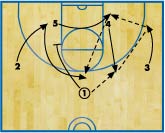
When running your motion offense, there are opportunities for 3-pointers. The following diagram is just one way to free up one of your better shooters.
DIAGRAM 5: Motion offense 3-pointer. 4 pops to the perimeter. 1 passes to 4. 4 passes to 3 fading toward the corner. 5 comes across the lane to the ball-side block. 3 passes to 5. 2, who moved into the weak-side post, now uses a screen from 1 to come free at the top of the key. 5 passes to 2 for the open 3-point shot.
3-pointers vs. zone
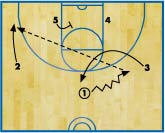
When facing a zone, Meyer said your team can score off a screen-in-and-skip, a step-out or a dribble-follow play. Also, try a box formation against a zone to create open looks for 3-pointers.
DIAGRAM 6: Screen-in-and-skip. 1 dribbles to the right. 3 curls to the top. 5 screen in to seal the lane. 1 throws a skip pass to 2 moving toward the opposite corner.

DIAGRAM 7: Step-out. 1 dribbles to the right. 3 curls to the top of the key. 1 passes passes to 3, while 2 moves toward the corner. 3 passes to 2.
2 dribbles back toward the top, while 4 comes across the lane to the ball-side corner. 2 passes to 4 for the shot.

DIAGRAM 8: Dribble-follow (A). 1 dribbles to the right. 3 curls to the top of the key. 1 passes to 3.
2 moves toward the corner, and 3 passes to 2.
5 and 4 remain on the low block tracking the ball.
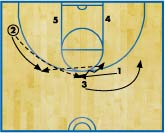
DIAGRAM 9: Dribble-follow (B). 1 moves to the top and 2 passes to 1. 1 dribbles to the right and 2 follows. 1 kicks the pass back to 2 for the open shot.
DIAGRAM 10: Box set with shooters on bottom. In this play, place your shooters in the blocks with your bigger players on the elbows. 1 dribbles right.
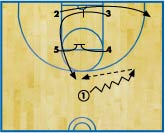
3 screens into the lane for 2. 2 uses the screen to move to the ball-side corner. 4 and 5 set a double screen at the foul line. 3 uses the double screen to come free at the top of the key. 1 passes to either 2 in the corner or 3 at the top.
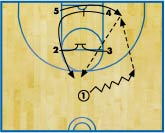
DIAGRAM 11: Box set with shooters on top. This time, your shooters are at the elbows and the big players are in the post. This is a good play when you have a post player who has 3-point-shooting abilities. 4 screens across for 5. 5 moves to the block side, where 1 is dribbling. 2 and 3 set a double screen for 4. 4 uses the double screen to come to the top of the set. 1 passes to 5 in the block. 5 passes to 4 at the top.
Baseline vs. zone
This is a simple baseline out-of-bounds play to use against a zone when you want an open 3-pointer.
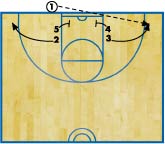
DIAGRAM 12: Baseline vs. zone. 4 and 5 screen the inside of the zone. 2 and 3 pop to the corners. 1 makes a strong pass fake to 1 in the near corner, then fires a pass to 3 in the far corner.












